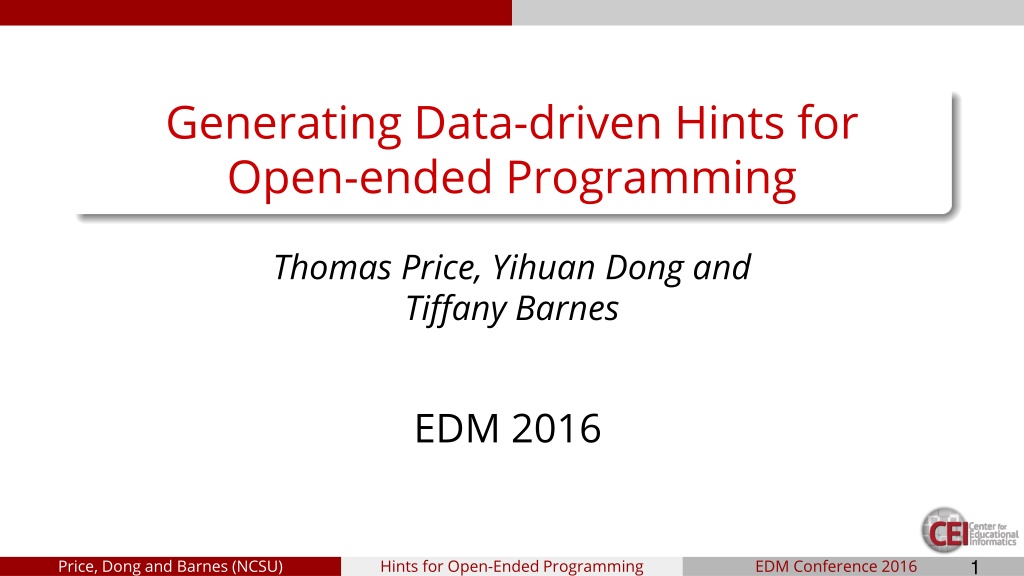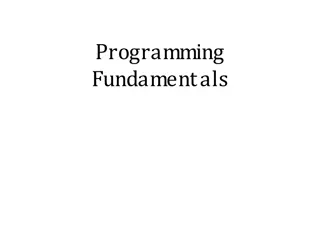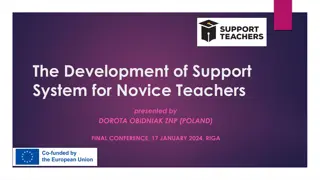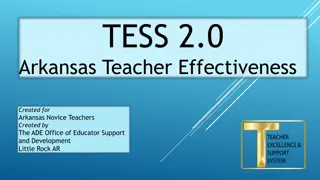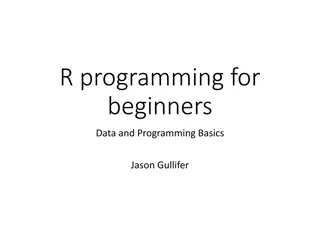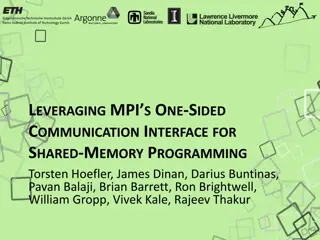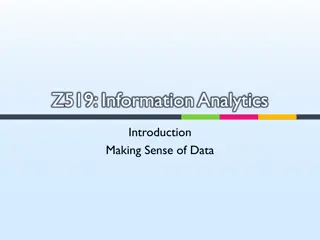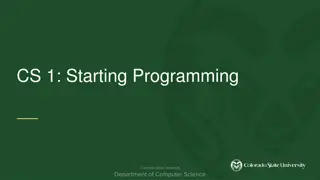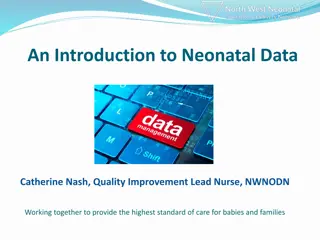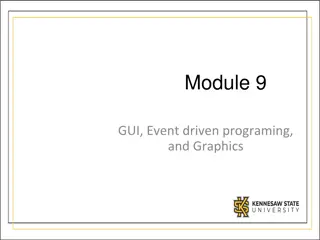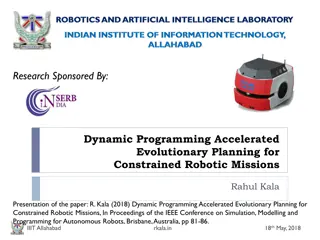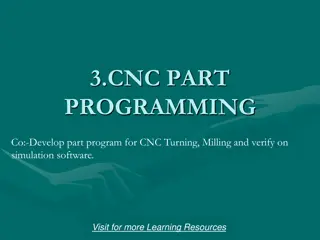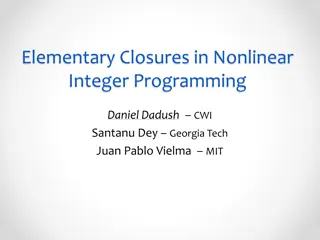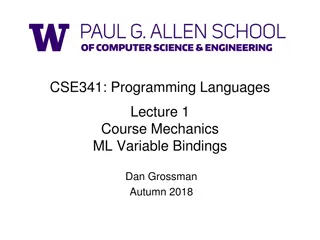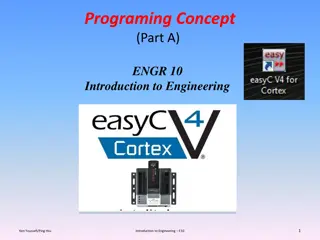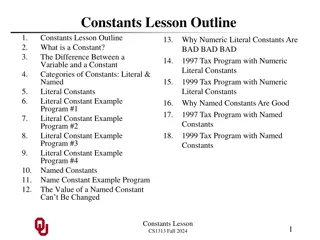Enhancing Novice Programming Environments with Data-Driven Hints
Effective learning tools like Intelligent Tutoring Systems (ITSs) and Novice Programming Environments (NPEs) are valuable in computer science education. This study aims to combine these technologies by creating ITS-like hints for NPEs, utilizing insights from programming education research to better support students in their learning journey.
Download Presentation

Please find below an Image/Link to download the presentation.
The content on the website is provided AS IS for your information and personal use only. It may not be sold, licensed, or shared on other websites without obtaining consent from the author. Download presentation by click this link. If you encounter any issues during the download, it is possible that the publisher has removed the file from their server.
E N D
Presentation Transcript
Generating Data-driven Hints for Open-ended Programming Thomas Price, Yihuan Dong and Tiffany Barnes EDM 2016 Price, Dong and Barnes (NCSU) Hints for Open-Ended Programming EDM Conference 2016 1
Introduction Motivation Intelligent Tutoring Systems (ITSs) are effective learning tools in Computer Science They improve performance in and out of the tutor (Corbett 2001) But, they are not commonly used to teach CS Price, Dong and Barnes (NCSU) Hints for Open-Ended Programming EDM Conference 2016 2
Introduction Motivation Intelligent Tutoring Systems (ITSs) are effective learning tools in Computer Science They improve performance in and out of the tutor (Corbett 2001) But, they are not commonly used to teach CS Novice Programming Environments (NPEs) are popular tools for introducing programming They improve retention (Moskal 2004) and test scores (Dann 2012) But, they lack support for struggling students Price, Dong and Barnes (NCSU) Hints for Open-Ended Programming EDM Conference 2016 3
Introduction Motivation Intelligent Tutoring Systems (ITSs) are effective learning tools in Computer Science They improve performance in and out of the tutor (Corbett 2001) But, they are not commonly used to teach CS Novice Programming Environments (NPEs) are popular tools for introducing programming They improve retention (Moskal 2004) and test scores (Dann 2012) But, they lack support for struggling students Goal: Combine these two effective technologies Create ITS-like hints for NPEs Price, Dong and Barnes (NCSU) Hints for Open-Ended Programming EDM Conference 2016 4
Background Novice Programming Environments NPE Example - Snap! Visual, block-based language Programmable sprites Low floor, high ceiling All in the browser Integrated with BJC Curriculum (Garcia 2015) Price, Dong and Barnes (NCSU) Hints for Open-Ended Programming EDM Conference 2016 5
Background Novice Programming Environments Novice Programming Environments Examples: Scratch, Alice, Greenfoot, Snap! Interesting: Let students create games, stories and simulations (Utting 2010) Innovative: Features like block-based programming reduce the burden of syntax (Price 2015a) Students use NPEs voluntarily and share knowledge (Maloney 2008) Popular: Used in classes, clubs camps and MOOCS Scratch is the 22nd most popular programming language (TIOBE Index, June 2016) Price, Dong and Barnes (NCSU) Hints for Open-Ended Programming EDM Conference 2016 6
Background Automated Hint Generation Intelligent Tutoring Systems Designed to play the role of a human tutor (VanLehn 2006) Guide students to better learning outcomes E.g., support students when they get stuck Outer Loop: problem selection (using student model) Inner Loop: Step-by-step support on one problem Next-step hints: answer "What do I do now?" questions Price, Dong and Barnes (NCSU) Hints for Open-Ended Programming EDM Conference 2016 7
Background Automated Hint Generation Data-driven Hint Generation Hint Factory (Barnes 2008) Use previous students' data to model problem solving strategies Successfully applied to many domains (e.g. logic proofs) Overcomes challenges of expert models: High cost of expert time (Murray 1999) "Expert blind spot" (Alibali 2001) Difficult to construct for large problem spaces Price, Dong and Barnes (NCSU) Hints for Open-Ended Programming EDM Conference 2016 8
Background Automated Hint Generation Interaction Networks Start State Actions (Edges) States Frequency Solution Path Goal State (Eagle 2012) Price, Dong and Barnes (NCSU) Hints for Open-Ended Programming EDM Conference 2016 9
Background Automated Hint Generation The Hint Factory Hint: Go Here You are Here Hint: Go Here You are Here Price, Dong and Barnes (NCSU) Hints for Open-Ended Programming EDM Conference 2016 10
Background Hint Generation in Programming The Guessing Game GuessingGame: Say( "Welcome to the Guessing Game!" ) answer Ask( "What is your name?" ) Say( Join( "Hello ", answer ) ) number Random( 1, 10 ) doUntil ( answer == number ): answer Ask( "Guess a number" ) if ( answer == number ): Say( "Correct!" ) else: if ( answer > number ): Say( "Too high!" ) if ( answer < number ): Say( "Too low!" ) Price, Dong and Barnes (NCSU) Hints for Open-Ended Programming EDM Conference 2016 11
Background Hint Generation in Programming Programming States GuessingGame: GuessingGame: Say( "Welcome to the Guessing Game!" ) answer Ask( "What is your name?" ) Say( Join( "Hello ", answer ) ) number Random( 1, 10 ) doUntil ( answer == number ): answer Ask( "Guess a number" ) if ( answer == number ): Say( "Correct!" ) else: if ( answer > number ): Say( "Too high!" ) if ( answer < number ): Say( "Too low!" ) GuessingGame: Say( ) GuessingGame: Say( "Welcome to the Guessing Game!" ) GuessingGame: Say( "Welcome to the Guessing Game!" ) answer GuessingGame: Say( "Welcome to the Guessing Game!" ) answer Ask( "What is your name?" )) Price, Dong and Barnes (NCSU) Hints for Open-Ended Programming EDM Conference 2016 12
Background Hint Generation in Programming Abstract Syntax Trees GuessingGame: Say( "Welcome to the Guessing Game!" ) answer Ask( "What is your name?" ) Say( Join( "Hello ", answer ) ) number Random( 1, 10 ) doUntil ( answer == number ): answer Ask( "Guess a number" ) if ( answer == number ): Say( "Correct!" ) else: if ( answer > number ): Say( "Too high!" ) if ( answer < number ): Say( "Too low!" ) Price, Dong and Barnes (NCSU) Hints for Open-Ended Programming EDM Conference 2016 13
Background Hint Generation in Programming Programming States Price, Dong and Barnes (NCSU) Hints for Open-Ended Programming EDM Conference 2016 14
Background Hint Generation in Programming Challenges of Using Data Programming is a challenge for data-driven methods Student solutions have very little overlap (Price 2015b) Challenges overcome by: Modeling the output of a program, rather than code (Hicks 2014) Canonicalizing code so that it overlaps more (Rivers 2012) Incorporating search to find new solutions (Rivers 2015) Related: Automated Hint Generation Start with a student program and search for a solution (Singh 2013) Or transform into a similar expert solution (Zimmerman 2015) Price, Dong and Barnes (NCSU) Hints for Open-Ended Programming EDM Conference 2016 15
Background Hint Generation in Programming Challenges of NPEs NPEs rely on open-ended programming assignments Many variations on a correct solution Students make meaningful design choices Multiple, interdependent goals Can we use current hint generation methods? Students solutions have almost no overlap Goals are difficult to automatically assess Price, Dong and Barnes (NCSU) Hints for Open-Ended Programming EDM Conference 2016 16
The CTD Algorithm Hint Generation for NPEs Contextual Tree Decomposition (CTD) Algorithm Is data driven, requiring no expert model or test cases Can operate with minimal overlap among students Price, Dong and Barnes (NCSU) Hints for Open-Ended Programming EDM Conference 2016 17
The CTD Algorithm Terminology Root Paths GuessingGame: Say( "Welcome to the Guessing Game!" ) answer Ask( "What is your name?" ) Say( Join( "Hello ", answer ) ) number Random( 1, 10 ) doUntil ( answer == number ): answer Ask( "Guess a number" ) if ( answer == number ): Say( "Correct!" ) else: if ( answer > number ): Say( "Too high!" ) if ( answer < number ): Say( "Too low!" ) Price, Dong and Barnes (NCSU) Hints for Open-Ended Programming EDM Conference 2016 18
The CTD Algorithm Terminology Root Paths GuessingGame: Say( "Welcome to the Guessing Game!" ) answer Ask( "What is your name?" ) Say( Join( "Hello ", answer ) ) number Random( 1, 10 ) doUntil ( answer == number ): answer Ask( "Guess a number" ) if ( answer == number ): Say( "Correct!" ) else: if ( answer > number ): Say( "Too high!" ) if ( answer < number ): Say( "Too low!" ) Price, Dong and Barnes (NCSU) Hints for Open-Ended Programming EDM Conference 2016 19
The CTD Algorithm Terminology Root Paths GuessingGame: Say( "Welcome to the Guessing Game!" ) answer Ask( "What is your name?" ) Say( Join( "Hello ", answer ) ) number Random( 1, 10 ) doUntil ( answer == number ): answer Ask( "Guess a number" ) if ( answer == number ): Say( "Correct!" ) else: if ( answer > number ): Say( "Too high!" ) if ( answer < number ): Say( "Too low!" ) Price, Dong and Barnes (NCSU) Hints for Open-Ended Programming EDM Conference 2016 20
The CTD Algorithm Terminology Contextual Interaction Networks (CINs) Root Path Price, Dong and Barnes (NCSU) Hints for Open-Ended Programming EDM Conference 2016 21
The CTD Algorithm Generating Hints Adding Students Input: a set of student solution paths from historical data Output: a set of CINs that model student problem solving strategies Price, Dong and Barnes (NCSU) Hints for Open-Ended Programming EDM Conference 2016 22
The CTD Algorithm Generating Hints Adding Students GuessingGame: Say( "Welcome to the Guessing Game!" ) answer Ask( "What is your name?" ) Say( Join( "Hello ", answer ) ) Price, Dong and Barnes (NCSU) Hints for Open-Ended Programming EDM Conference 2016 23
The CTD Algorithm Generating Hints Adding Students GuessingGame: Say( "Welcome to the Guessing Game!" ) answer Ask( "What is your name?" ) Say( Join( "Hello ", answer ) ) answer Ask( "Guess a number" ) Price, Dong and Barnes (NCSU) Hints for Open-Ended Programming EDM Conference 2016 24
The CTD Algorithm Generating Hints Adding Students GuessingGame: Say( "Welcome to the Guessing Game!" ) answer Ask( "What is your name?" ) Say( Join( "Hello ", answer ) ) answer Ask( "Guess a number" ) doUntil ( answer == ): Price, Dong and Barnes (NCSU) Hints for Open-Ended Programming EDM Conference 2016 25
The CTD Algorithm Generating Hints Adding Students GuessingGame: Say( "Welcome to the Guessing Game!" ) answer Ask( "What is your name?" ) Say( Join( "Hello ", answer ) ) answer Ask( "Guess a number" ) doUntil ( answer == Random(1, 10) ): Price, Dong and Barnes (NCSU) Hints for Open-Ended Programming EDM Conference 2016 26
The CTD Algorithm Generating Hints Adding Students GuessingGame: Say( "Welcome to the Guessing Game!" ) answer Ask( "What is your name?" ) Say( Join( "Hello ", answer ) ) doUntil ( answer == Random(1, 10) ): answer Ask( "Guess a number" ) Price, Dong and Barnes (NCSU) Hints for Open-Ended Programming EDM Conference 2016 27
The CTD Algorithm Generating Hints Adding Students GuessingGame: Say( "Welcome to the Guessing Game!" ) answer Ask( "What is your name?" ) Say( Join( "Hello ", answer ) ) number Random( 1, 10 ) doUntil ( answer == Random(1, 10) ): answer Ask( "Guess a number" ) Price, Dong and Barnes (NCSU) Hints for Open-Ended Programming EDM Conference 2016 28
The CTD Algorithm Generating Hints Adding Students GuessingGame: Say( "Welcome to the Guessing Game!" ) answer Ask( "What is your name?" ) Say( Join( "Hello ", answer ) ) number Random( 1, 10 ) doUntil ( answer == ): answer Ask( "Guess a number" ) Price, Dong and Barnes (NCSU) Hints for Open-Ended Programming EDM Conference 2016 29
The CTD Algorithm Generating Hints Adding Students GuessingGame: Say( "Welcome to the Guessing Game!" ) answer Ask( "What is your name?" ) Say( Join( "Hello ", answer ) ) number Random( 1, 10 ) doUntil ( answer == number ): answer Ask( "Guess a number" ) Price, Dong and Barnes (NCSU) Hints for Open-Ended Programming EDM Conference 2016 30
The CTD Algorithm Generating Hints Adding Students GuessingGame: Say( "Welcome to the Guessing Game!" ) answer Ask( "What is your name?" ) Say( Join( "Hello ", answer ) ) number Random( 1, 10 ) doUntil ( answer == number ): answer Ask( "Guess a number" ) Price, Dong and Barnes (NCSU) Hints for Open-Ended Programming EDM Conference 2016 31
The CTD Algorithm Generating Hints Providing Hints Input: the set of CINs and the student's current code Output: a set of hints Price, Dong and Barnes (NCSU) Hints for Open-Ended Programming EDM Conference 2016 32
The CTD Algorithm Generating Hints Providing Hints GuessingGame: number 8 Say( "Hi! Let's play." ) answer Ask( "Who's playing?" ) Say( Join( "Sup ", answer ) ) doUntil ( answer == Random( 1, 10) ): answer Ask( "Guess a number" ) Price, Dong and Barnes (NCSU) Hints for Open-Ended Programming EDM Conference 2016 33
The CTD Algorithm Generating Hints Providing Hints GuessingGame: number 8 Say( "Hi! Let's play." ) answer Ask( "Who's playing?" ) Say( Join( "Sup ", answer ) ) doUntil ( answer == Random( 1, 10) ): answer Ask( "Guess a number" ) Price, Dong and Barnes (NCSU) Hints for Open-Ended Programming EDM Conference 2016 34
The CTD Algorithm Generating Hints Providing Hints GuessingGame: number 8 Say( "Hi! Let's play." ) answer Ask( "Who's playing?" ) Say( Join( "Sup ", answer ) ) doUntil ( answer == Random( 1, 10) ): answer Ask( "Guess a number" ) Price, Dong and Barnes (NCSU) Hints for Open-Ended Programming EDM Conference 2016 35
The CTD Algorithm Generating Hints Providing Hints GuessingGame: number 8 Say( "Hi! Let's play." ) answer Ask( "Who's playing?" ) Say( Join( "Sup ", answer ) ) doUntil ( answer == Random( 1, 10) ): answer Ask( "Guess a number" ) Price, Dong and Barnes (NCSU) Hints for Open-Ended Programming EDM Conference 2016 36
Technical Evaluation Methods Technical Evaluation Used historical data: 51 students in an intro CS course for non-majors Logs from in-lab work on the Guessing Game assignment 9109 program snapshots - very sparse: 85% of snapshots found in only one submission 92% of submissions had a unique solution Hint generation: Used CTD to generate hints for each snapshot Hints for each student were generated with the other 50 students' data Price, Dong and Barnes (NCSU) Hints for Open-Ended Programming EDM Conference 2016 37
Technical Evaluation Methods Hint Policies 1.CTD All: CTD hints using all data (n=51). 2.CTD Exemplar: CTD hints using data from correct submissions (n=32). 3.Direct Expert*: Direct modification towards an ideal solution. 4.Direct Student*: Direct modification towards the student's own solution. *Generated using (Zimmerman 2015) Price, Dong and Barnes (NCSU) Hints for Open-Ended Programming EDM Conference 2016 38
Technical Evaluation Analysis Can CTD Provide Hints Reliably? Repeatedly applied hints to 50 time-slices from each student's work CTD hints could finish the assignment from all slices CTD All policy solutions achieved 89.5-93.2% of objectives Imperfect solutions all missed the same objective CTD Exemplar achieved 98.5-100% Number of hints needed decreased linearly with time Price, Dong and Barnes (NCSU) Hints for Open-Ended Programming EDM Conference 2016 39
Technical Evaluation Analysis Can CTD Provide Hints Reliably? CTD All CTD Exemplar Price, Dong and Barnes (NCSU) Hints for Open-Ended Programming EDM Conference 2016 40
Technical Evaluation Analysis Do CTD Hints Satisfy Objectives? Do hints complete new objectives? Generated hints for all snapshots Identified when a hint would complete an uncompleted objective (before the student) Price, Dong and Barnes (NCSU) Hints for Open-Ended Programming EDM Conference 2016 41
Technical Evaluation Analysis Do CTD Hints Satisfy Objectives? CTD All CTD Exemplar Direct Expert Direct Student Price, Dong and Barnes (NCSU) Hints for Open-Ended Programming EDM Conference 2016 42
Technical Evaluation Analysis Do CTD Hints Satisfy Objectives? Do hints complete new objectives? Generated hints for all snapshots Identified when a hint would complete an uncompleted objective (before the student) Do hints undo objectives? Generated hints for each snapshot For each objective a student completed: Counted if a hint "undid" the complete objective Price, Dong and Barnes (NCSU) Hints for Open-Ended Programming EDM Conference 2016 43
Technical Evaluation Analysis Do CTD Hints Satisfy Objectives? CTD All CTD Exemplar Direct Expert Direct Student Price, Dong and Barnes (NCSU) Hints for Open-Ended Programming EDM Conference 2016 44
Technical Evaluation Analysis Are CTD Hints Reasonable? Reasonable hints should get students closer to their submitted solution Counted the percent of hints which got students closer Compared with student's own actions D.E. < C.E. < C.A. = D.S. < S.N. (blue = significant differences) Percent of hints that get closer for each policy. Price, Dong and Barnes (NCSU) Hints for Open-Ended Programming EDM Conference 2016 45
Technical Evaluation Discussion Discussion Are these results good? Yes! Hints are always available and lead to solutions Despite 85% of snapshots and 92% of solutions being unique They identify objectives most of the time without undoing them They're as good as the Direct Student policy at pointing a student toward their final solution But... there is still much work to do Price, Dong and Barnes (NCSU) Hints for Open-Ended Programming EDM Conference 2016 46
Demo! http://go.ncsu.edu/isnap Price, Dong and Barnes (NCSU) Hints for Open-Ended Programming EDM Conference 2016 47
Thank You! Questions? Thomas Price (twprice@ncsu.edu) http://go.ncsu.edu/isnap Price, Dong and Barnes (NCSU) Hints for Open-Ended Programming EDM Conference 2016 48
References Barnes, T., & Stamper, J. (2008). Toward Automatic Hint Generation for Logic Proof Tutoring Using Historical Student Data. In Proceedings of the 9th International Conference on Intelligent Tutoring Systems (pp. 373 382). Corbett, A., & Anderson, J. (2001). Locus of Feedback Control in Computer-Based Tutoring: Impact on Learning Rate, Achievement and Attitudes. In Proceedings of the SIGCHI Conference on Human Computer Interaction (pp. 245 252). Dann, W., Cosgrove, D., & Slater, D. (2012). Mediated Transfer: Alice 3 to Java. In Proceedings of the 43rd ACM Technical Symposium on Computer Science Education (pp. 141 146). Hicks, A., Peddycord III, B., & Barnes, T. (2014). Building Games to Learn from Their Players: Generating Hints in a Serious Game. In Proceedings of the 12th International Conference on Intelligent Tutoring Systems (pp. 312 317). Moskal, B., Lurie, D., & Cooper, S. (2004). Evaluating the Effectiveness of a New Instructional Approach. ACM SIGCSE Bulletin, 36(1), 75 79. Price, T. W., & Barnes, T. (2015a). Comparing Textual and Block Interfaces in a Novice Programming Environment. In Proceedings of the 11th International Computing Education Research Conference. Price, T. W., & Barnes, T. (2015b). An Exploration of Data-Driven Hint Generation in an Open-Ended Programming Problem. In Proceedings of the Workshop on Graph-Based Data Mining held at EDM 15. Rivers, K., & Koedinger, K. (2013). Automatic Generation of Programming Feedback: A Data-driven Approach. In Proceedings of the First Workshop on AI-supported Education for Computer Science (pp. 50 59). Price, Dong and Barnes (NCSU) Hints for Open-Ended Programming EDM Conference 2016 49
References, Cont. Rivers, K., & Koedinger, K. R. (2015). Data-Driven Hint Generation in Vast Solution Spaces: a Self-Improving Python Programming Tutor. International Journal of Artificial Intelligence in Education, 16(1). Singh, R., Gulwani, S., & Solar-Lezama, A. (2013). Automated Feedback Generation for Introductory Programming Assignments. ACM SIGPLAN Notices, 48(6). Utting, I., Cooper, S., & K lling, M. (2010). Alice, Greenfoot, and Scratch -- A Discussion. ACM Transactions on Computing Education, 10(4). Vanlehn, K. (2006). The Behavior of Tutoring Systems. International Journal of Artifical Intelligence in Education, 16(3), 227 265. Zimmerman, K., & Rupakheti, C. R. (2015). An Automated Framework for Recommending Program Elements to Novices. In Proceedings of the 30th International Conference on Automated Software Engineering. Price, Dong and Barnes (NCSU) Hints for Open-Ended Programming EDM Conference 2016 50
